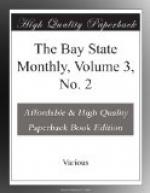The great sources of Gothic romance are a British History of Arthur and his wizzard, Merlin, by Walter, Archdeacon of Oxford, translated into Latin by Geoffrey of Monmouth; the history of Charlemagne and his twelve peers, forged by Turpin, a monk of the eighth century; the History of Troy, in two Latin works, which passed under the names of Dares Phrygius and Dictys Cretensis; and the History of Alexander the Great, originally written in Persic and translated into Greek by Simeon Seth, A.D. 1070, and again turned into Latin by Giraldus Cambrensis about the year 1200. These four works with variations, additions, and dilutions, formed the staple of romantic fiction in verse in the Dark Ages.
The minor songs and ballads which were called forth by passing events were usually amorous, sportive, gay, and often gross, yet suited to a rude age.
Ellis in his specimens of the early English poets has given us sketches of one hundred and sixty-one writers of songs from the year 1230 to 1650, after a careful search through this whole period for literary gems. The first edition of his work consisted almost entirely of love songs and sonnets; the revised edition has greater variety; but our circle of ideas is so enlarged, our habits are so different from those of by-gone centuries, that we look over this rare collection of old poems, rather to learn the manners of the people, than to enjoy the diction of their songs. We cannot doubt that this species of poetry excited an important influence when it was the staple of popular education and amusement.
A maxim is current among us which has been successively ascribed to many great thinkers, which shows the value usually set on compositions of this kind. It is this: “Let me make the songs of a people and I care not who makes their laws.”
A ballad is a story in verse whose incidents awaken the sympathies and excite the passions of those who listen. The song is designed to express deep emotion, joy or sorrow, hope or fear and appeals directly to the feelings. Here, often, the singing is more than the sentiment; the tones of the chanter are often more touching than the thoughts of the Emperor. A national ode must have a national element in it; it must reflect the passions that burn in the people’s breasts. Local topics, too, may call forth a general interest when they describe trials or triumphs which all may share. Says Carlyle: “In a peasant’s death-bed there may be the fifth act of a tragedy. In the ballad which details the adventures and the fate of a partisan warrior or a love-lorn knight,—the foray of a border chieftain or the lawless bravery of a forrester; a Douglass, or a Robin Hood,—there may be the materials of a rich romance. Whatever be the subject of the song, high or low, sacred or secular, there is this peculiarity about it, it expresses essentially the popular spirit, the common sentiment, which the rudest breast may feel, yet which is not beneath the most cultivated. It is peculiarly the birth of the popular affections. It celebrates some event which the universal heart clings to, which, for joy or sorrow, awaken the memories of every mind.” Hence we learn the history of a nation’s heart from their songs as we learn their martial history from their armor.




